Environmental and Agro-Economic Sustainability of Olive Orchards Irrigated with Reclaimed Water under Deficit Irrigation
Abstract
:1. Introduction
2. Materials and Methods
2.1. Study Site and Treatments Description
- i.
- Control treatment (T1), which received an irrigation volume corresponding to 100% of the crop water requirements (ETc), using surface drip lines consisting of 4 emitters per tree, with a flow rate of 7.9 L h−1 each, at 1 bar, and a total discharge of 31.6 L h−1 per tree;
- ii.
- DI treatment (T2), supplied with 80% of ETc, alternatively on the two sides of the root system, using the PRD strategy, on weekly basis. PRD involved the use of 2 separate surface drip lines consisting of 4 emitters, with a flow rate of 4.0 and 2.1 L h−1 (at 1 bar), respectively, and a total discharge of 24.4 L h−1 per tree;
- iii.
- DI treatment (T3), where a constant reduction of 50% of the irrigation volume was applied using surface drip lines consisting of 4 emitters, with a flow rate of 4.0 L h−1 (at 1 bar) per tree and a total discharge of 16 L h−1 per tree.
2.1.1. Treatment Wetland System and Removal Efficiency
2.1.2. Scheduling Irrigation Volumes
2.2. Crop Water Status Evaluation
2.2.1. Ground-Based Physiological Monitoring
2.2.2. Satellite-Based Biophysical Indices
2.3. Qualitative Characteristics of the Olive Oil
2.4. Evaluation of the Economic and Environmental Sustainability of the Olive Orchard
3. Results
3.1. Treatment Wastewater Efficiency
3.2. Irrigation Volumes and Water Savings
3.3. Crop Water Status Response
3.3.1. Ground-Based Physiological Indicators
3.3.2. Satellite-Based Biophysical Indices
3.4. Effects on Olive Oil Qualitative Parameters
3.5. Economic and Environmental Assessment of the Sustainable Irrigation Practices
4. Discussion
5. Conclusions
- (i)
- The application of DI strategies allowed us to obtain water savings up to 50% and 20% under the PRD (T2) and SDI (T3), respectively, compared to the control treatment (T1), under both FW and RW conditions. These findings are translated into both economic and environmental advantages;
- (ii)
- Different olive cultivars under FW and RW determine a certain degree of variability both in terms of crop response (Ψ) and fatty acid composition;
- (iii)
- No differences were found for the RWC of the leaves under FW or RW scenarios. This behavior was also reflected in terms of satellite-based indicators;
- (iv)
- A significant reduction in the economic impacts of the water deficit regimes was obtained using RW. Specifically, the T2_RW scenario was capable of remunerating the factors of production used to a greater extent at market prices.
Supplementary Materials
Author Contributions
Funding
Institutional Review Board Statement
Informed Consent Statement
Data Availability Statement
Acknowledgments
Conflicts of Interest
References
- Gucci, R.; Caruso, G.; Gennai, C.; Esposto, S.; Urbani, S.; Servili, M. Fruit growth, yield and oil quality changes induced by deficit irrigation at different stages of olive fruit development. Agric. Water Manag. 2019, 212, 88–98. [Google Scholar] [CrossRef]
- Orlandi, F.; Rojo, J.; Picornell, A.; Oteros, J.; Pérez-Badia, R.; Fornaciari, M. Impact of Climate Change on Olive Crop Production in Italy. Atmosphere 2020, 11, 595. [Google Scholar] [CrossRef]
- MiPAAF. Piano di Settore Olivicolo Oleario. Ministero delle Politiche Agricole Alimentari e Forestali, Roma, Italy. 2016. Available online: https://www.politicheagricole.it/flex/cm/pages/ServeBLOB.php/L/IT/IDPagina/1984 (accessed on 7 February 2023).
- Consoli, S.; Licciardello, F.; Vanella, D.; Pasotti, L.; Villani, G.; Tomei, F. Testing the water balance model criteria using TDR measurements, micrometeorological data and satellite-based information. Agric. Water Manag. 2016, 170, 68–80. [Google Scholar] [CrossRef]
- Consoli, S.; Stagno, F.; Vanella, D.; Boaga, J.; Cassiani, G.; Roccuzzo, G. Partial root-zone drying irrigation in orange orchards: Effects on water use and crop production characteristics. Eur. J. Agron. 2017, 82, 190–202. [Google Scholar] [CrossRef]
- Rubio-Asensio, J.S.; Abbatantuono, F.; Ramírez-Cuesta, J.M.; Hortelano, D.; Ruíz, J.L.; Parra, M.; Martínez-Meroño, R.M.; Intrigliolo, D.S.; Buesa, I. Effects of Cover Crops and Drip Fertigation Regime in a Young Almond Agroecosystem. Agronomy 2022, 12, 2606. [Google Scholar] [CrossRef]
- Martínez-Moreno, A.; Pérez-Álvarez, E.P.; Intrigliolo, D.S.; Mirás-Avalos, J.M.; López-Urrea, R.; Gil-Muñoz, R.; Lizama, V.; García-Esparza, M.J.; Álvarez, M.I.; Buesa, I. Effects of deficit irrigation with saline water on yield and grape composition of Vitis vinifera L. cv. Monastrell. Irrig. Sci. 2022, 41, 469–485. [Google Scholar] [CrossRef]
- Saitta, D.; Consoli, S.; Ferlito, F.; Torrisi, B.; Allegra, M.; Longo-Minnolo, G.; Ramírez-Cuesta, J.M.; Vanella, D. Adaptation of citrus orchards to deficit irrigation strategies. Agric. Water Manag. 2021, 247, 106734. [Google Scholar] [CrossRef]
- González-Gómez, L.; Intrigliolo, D.S.; Rubio-Asensio, J.S.; Buesa, I.; Ramírez-Cuesta, J.M. Assessing almond response to irrigation and soil management practices using vegetation indexes time-series and plant water status measurements. Agric. Ecosyst. Environ. 2022, 339, 108124. [Google Scholar] [CrossRef]
- Fernández, J.E.; Alcon, F.; Diaz-Espejo, A.; Hernandez-Santana, V.; Cuevas, M.V. Water use indicators and economic analysis for on-farm irrigation decision: A case study of a super high density olive tree orchard. Agric. Water Manag. 2020, 237, 106074. [Google Scholar] [CrossRef]
- Pellegrini, G.; Ingrao, C.; Camposeo, S.; Tricase, C.; Conto, F.; Huisingh, D. Application of water footprint to olive growing systems in the Apulia region: A comparative assessment. J. Clean. Prod. 2016, 112, 2407–2418. [Google Scholar] [CrossRef]
- Ventura, D.; Consoli, S.; Barbagallo, S.; Marzo, A.; Vanella, D.; Licciardello, F.; Cirelli, G.L. How to overcome barriers for wastewater agricultural reuse in Sicily (Italy)? Water 2019, 11, 335. [Google Scholar] [CrossRef]
- Kesari, K.K.; Soni, R.; Jamal, Q.M.S.; Tripathi, P.; Lal, J.A.; Jha, N.K.; Siddiqui, M.H.; Kumar, P.; Tripathi, V.; Ruokolainen, J. Wastewater treatment and reuse: A review of its applications and health implications. Water Air Soil Pollut. 2021, 232, 208. [Google Scholar] [CrossRef]
- Pedrero, F.; Grattan, S.R.; Ben-Gal, A.; Vivaldi, G.A. Opportunities for expanding the use of wastewaters for irrigation of olives. Agric. Water Manag. 2020, 241, 106333. [Google Scholar] [CrossRef]
- De Luca, A.I.; Falcone, G.; Stillitano, T.; Iofrida, N.; Strano, A.; Gulisano, G. Evaluation of sustainable innovations in olive growing systems: A Life Cycle Sustainability Assessment case study in southern Italy. J. Clean. Prod. 2018, 171, 1187–1202. [Google Scholar] [CrossRef]
- Iofrida, N.; Stillitano, T.; Falcone, G.; Gulisano, G.; Nicolo, B.F.; De Luca, A.I. The socio-economic impacts of organic and conventional olive growing in Italy. New Medit 2020, 19, 117–131. [Google Scholar] [CrossRef]
- Maesano, G.; Chinnici, G.; Falcone, G.; Bellia, C.; Raimondo, M.; D’Amico, M. Economic and environmental sustainability of olive production: A case study. Agronomy 2021, 11, 1753. [Google Scholar] [CrossRef]
- Maffia, A.; Pergola, M.; Palese, A.M.; Celano, G. Environmental impact assessment of organic vs. integrated olive-oil systems in Mediterranean context. Agronomy 2020, 10, 416. [Google Scholar] [CrossRef]
- Arborea, S.; Giannoccaro, G.; De Gennaro, B.C.; Iacobellis, V.; Piccinni, A.F. Cost–benefit analysis of wastewater reuse in Puglia, Southern Italy. Water 2017, 9, 175. [Google Scholar] [CrossRef]
- Moriana, A.; Orgaz, F.; Pastor, M.; Fereres, E. Yield Responses of a Mature Olive Orchard to Water Deficits. J. Am. Soc. Hortic. Sci. 2003, 128, 425–431. [Google Scholar] [CrossRef]
- Goldhamer, D.A. Regulated deficit irrigation for California canning olives. In Proceedings of the III International Symposium on Olive Growing, Chania, Greece, 22–26 September 1997; Volume 474, pp. 369–372. [Google Scholar]
- APHA. Standard Methods for the Examination of Water and Waste Water, 22nd ed.; American Public Health Association, American Water Works Association, Water Environment Federation: Washington, DC, USA, 2012. [Google Scholar]
- Marzo, A.; Ventura, D.; Cirelli, G.L.; Aiello, R.; Vanella, D.; Rapisarda, R.; Barbagallo, S.; Consoli, S. Hydraulic reliability of a horizontal wetland for wastewater treatment in Sicily. Sci. Total Environ. 2018, 636, 94–106. [Google Scholar] [CrossRef]
- Legislative Decree 152. Decreto Legislativo 3 aprile 2006, n. 152, “Norme in materia ambientale” GU n. 88 del 14 aprile 2006, Supplemento Ordinario n. 2006. Available online: https://www.gazzettaufficiale.it/dettaglio/codici/materiaAmbientale (accessed on 8 May 2023).
- Ministerial Decree 185. Decreto Ministeriale 12 giugno 2003, n. 185. “Norme tecniche per il riutilizzo delle acque reflue” GU n. 169 del 23-07-2003. 2003. Available online: https://www.gazzettaufficiale.it/eli/id/2003/07/23/003G0210/sg (accessed on 8 May 2023).
- Allen, R.G.; Pereira, L.S.; Raes, D.; Smith, M. Crop Evapotraspiration—Guidelines for Computing Crop Water Requirements; FAO Irrigation and Drainage Paper No. 56; FAO: Rome, Italy, 1998. [Google Scholar]
- Pastor, M.; Orgaz, F. Los programas de recorte de riego en olivar. Agricultura 1994, 746, 768–776. [Google Scholar]
- Fereres, E.; Pruitt, W.O.; Beutel, J.A.; Henderson, D.W.; Holzapfel, E.; Schulbach, H.; Uriu, K. Evapotranspiration and Drip Irrigation Scheduling. In Drip Irrigation Management; University of California: Riverside, CA, USA, 1981; Volume 21. [Google Scholar]
- Keller, J.; Karmeli, D. Trickle irrigation design parameters. Trans. ASAE 1974, 17, 678–0684. [Google Scholar] [CrossRef]
- Dichio, B.; Xiloyannis, C.; Sofo, A.; Montanaro, G. Osmotic Regulation in Leaves and Roots of Olive Trees during a Water Deficit and Rewatering. Tree Physiol. 2006, 26, 179–185. [Google Scholar] [CrossRef] [PubMed]
- Torres, I.; Sanchez, M.T.; Benlloch-Gonzalez, M.; Perez-Marin, D. Irrigation decision support based on leaf relative water content determination in olive grove using near infrared spectroscopy. Biosyst. Eng. 2019, 180, 50–58. [Google Scholar] [CrossRef]
- Vanino, S.; Nino, P.; De Michele, C.; Bolognesi, S.F.; D’Urso, G.; Di Bene, C.; Pennelli, B.; Vuolo, F.; Farina, R.; Pulighe, G.; et al. Capability of Sentinel-2 data for estimating maximum evapotranspiration and irrigation requirements for tomato crop in Central Italy. Remote Sens. Environ. 2018, 215, 452–470. [Google Scholar] [CrossRef]
- Rouse, J.W., Jr.; Haas, R.H.; Schelle, J.A.; Deering, D.W.; Harlan, J.C. Monitoring the Vernal Advancement or Retrogradation of Natural Vegetation. 1974. Available online: https://ntrs.nasa.gov/citations/19740022555 (accessed on 8 May 2023).
- Weiss, M.; Baret, F. S2ToolBox Level 2 Products: LAI, FAPAR, FCOVER (V1.1). 2016. Available online: https://step.esa.int/docs/extra/ATBD_S2ToolBox_L2B_V1.1.pdf (accessed on 8 May 2023).
- Pardo, G.; Aibar, J.; Cavero, J.; Zaragoza, C. Economic evaluation of cereal cropping systems under semiarid conditions: Minimum input, organic and conventional. Sci. Agric. 2009, 66, 615–621. [Google Scholar] [CrossRef]
- Sartori, L.; Basso, B.; Bertocco, M.; Oliviero, G. Energy use and economic evaluation of a three year crop rotation for conservation and organic farming in NE Italy. Biosyst. Eng. 2005, 91, 245–256. [Google Scholar] [CrossRef]
- Testa, R.; Di Trapani, A.M.; Sgroi, F.; Tudisca, S. Economic analysis of process innovations in the management of olive farms. Am. J. Appl. Sci. 2014, 11, 1486–1491. [Google Scholar] [CrossRef]
- Bernardi, B.; Falcone, G.; Stillitano, T.; Benalia, S.; Strano, A.; Bacenetti, J.; De Luca, A.I. Harvesting system sustainability in Mediterranean olive cultivation. Sci. Total Environ. 2018, 625, 1446–1458. [Google Scholar] [CrossRef]
- Falcone, G.; Stillitano, T.; Montemurro, F.; De Luca, A.I.; Gulisano, G.; Strano, A. Environmental and economic assessment of sustainability in Mediterranean wheat production. Agron. Res. 2019, 17, 60–76. [Google Scholar] [CrossRef]
- Nicoletti, G.M.; Notarnicola, B. Life Cycle Impact Assessment: A Case Study. Life Cycle Impact Assessment: A Case Study. J. Commod. Sci. 1998, 37, 127–147. [Google Scholar]
- Di Vita, G.; Bellia, C.; Pappalardo, G.; D’Amico, M. The Role of Innovation and Organization in Small Size Wineries: The Case of Malvasia delle Lipari PDO Wine. Qual.-Access Success 2013, 14, 107–112. [Google Scholar]
- ISO 14044; Environmental Management—Life Cycle Assessment—Requirements and Guidelines. ISO: Geneva, Switzerland, 2006.
- De Gennaro, B.; Notarnicola, B.; Roselli, L.; Tassielli, G. Innovative olive-growing models: An environmental and economic assessment. J. Clean. Prod. 2012, 28, 70–80. [Google Scholar] [CrossRef]
- Espadas-Aldana, G.; Vialle, C.; Belaud, J.P.; Vaca-Garcia, C.; Sablayrolles, C. Analysis and trends for Life Cycle Assessment of olive oil production. Sustain. Prod. Consum. 2019, 19, 216–230. [Google Scholar] [CrossRef]
- Salomone, R.; Cappelletti, G.M.; Ioppolo, G.; Mistretta, M.; Nicoletti, G.; Notarnicola, B.; Olivieri, G.; Pattara, C.; Russo, C.; Scimia, E. Italian experiences in life cycle assessment of olive oil: A survey and critical review. In Proceedings of the VII International Conference on Life Cycle Assessment in the Agri-Food Sector, Bari, Italy, 22–24 September 2010; Volume 1. [Google Scholar]
- Stillitano, T.; Falcone, G.; De Luca, A.I.; Piga, A.; Conte, P.; Strano, A.; Gulisano, G. Innovative technologies in evo oil extraction: An economic and environmental impact analysis. Riv. Ital. Delle Sostanze Grasse 2019, 96, 223–230. [Google Scholar]
- Tziolas, E.; Bournaris, T. Economic and Environmental Assessment of Agro-Energy Districts in Northern Greece: A Life Cycle Assessment Approach. BioEnergy Res. 2019, 12, 1145–1162. [Google Scholar] [CrossRef]
- Boano, F.; Caruso, A.; Costamagna, E.; Ridolfi, L.; Fiore, S.; Demichelis, F.; Galvão, A.; Pisoeiro, J.; Rizzo, A.; Masi, F. A review of nature-based solutions for greywater treatment: Applications, hydraulic design, and environmental benefits. Sci. Total Environ. 2020, 711, 134731. [Google Scholar] [CrossRef]
- Castellar, J.A.; Torrens, A.; Buttiglieri, G.; Monclús, H.; Arias, C.A.; Carvalho, P.N.; Galvao, A.; Comas, J. Nature-based solutions coupled with advanced technologies: An opportunity for decentralized water reuse in cities. J. Clean. Prod. 2022, 340, 130660. [Google Scholar] [CrossRef]
- Fernandes, J.P.; Guiomar, N. Nature-based solutions: The need to increase the knowledge on their potentialities and limits. Land Degrad. Dev. 2018, 29, 1925–1939. [Google Scholar] [CrossRef]
- García-Herrero, L.; Lavrnić, S.; Guerrieri, V.; Toscano, A.; Milani, M.; Cirelli, G.L.; Vittuari, M. Cost-benefit of green infrastructures for water management: A sustainability assessment of full-scale constructed wetlands in Northern and Southern Italy. Ecol. Eng. 2022, 185, 106797. [Google Scholar] [CrossRef]
- Milani, M.; Consoli, S.; Marzo, A.; Pino, A.; Randazzo, C.; Barbagallo, S.; Cirelli, G.L. Treatment of winery wastewater with a multistage constructed wetland system for irrigation reuse. Water 2020, 12, 1260. [Google Scholar] [CrossRef]
- Snep, R.P.; Voeten, J.G.; Mol, G.; Van Hattum, T. Nature based solutions for urban resilience: A distinction between no-tech, low-tech and high-tech solutions. Front. Environ. Sci. 2020, 8, 599060. [Google Scholar] [CrossRef]
- Watkin, L.J.; Ruangpan, L.; Vojinovic, Z.; Weesakul, S.; Torres, A.S. A framework for assessing benefits of implemented nature-based solutions. Sustainability 2019, 11, 6788. [Google Scholar] [CrossRef]
- O’Hogain, S.; McCarton, L. A technology portfolio of nature based solutions. In A Technology Portfolio of Nature Based Solutions: Innovations in Water Management; Springer: Cham, Switzerland, 2018. [Google Scholar] [CrossRef]
- Nguyen, X.C.; Nguyen, D.D.; Tran, Q.B.; Nguyen, T.H.; Tran, T.A.; Tran, T.P.; Nguyen, T.H.G.; Tran, T.N.T.; La, D.D.; Chang, S.W.; et al. Two-step system consisting of novel vertical flow and free water surface constructed wetland for effective sewage treatment and reuse. Bioresour. Technol. 2020, 306, 123095. [Google Scholar] [CrossRef]
- Molina-Moral, J.C.; Moriana-Elvira, A.; Pérez-Latorre, F.J. The Sustainability of Irrigation Strategies in Traditional Olive Orchards. Agronomy 2021, 12, 64. [Google Scholar] [CrossRef]
- Bedbabis, S.; Ferrara, G.; Rouina, B.B.; Boukhris, M. Effects of irrigation with treated wastewater on olive tree growth, yield and leaf mineral elements at short term. Sci. Hortic. 2010, 126, 345–350. [Google Scholar] [CrossRef]
- Bedbabis, S.; Trigui, D.; Ahmed, C.B.; Clodoveo, M.L.; Camposeo, S.; Vivaldi, G.A.; Rouina, B.B. Long-terms effects of irrigation with treated municipal wastewater on soil, yield and olive oil quality. Agric. Water Manag. 2015, 160, 14–21. [Google Scholar] [CrossRef]
- Bedbabis, S.; Ferrara, G. Effects of long term irrigation with treated wastewater on leaf mineral element contents and oil quality in Olive cv. Chemlali. J. Hortic. Sci. Biotechnol. 2018, 93, 216–223. [Google Scholar] [CrossRef]
- de Vito, R.; Portoghese, I.; Pagano, A.; Fratino, U.; Vurro, M. An index-based approach for the sustainability assessment of irrigation practice based on the water-energy-food nexus framework. Adv. Water Resour. 2017, 110, 423–436. [Google Scholar] [CrossRef]
- Caruso, G.; Zarco-Tejada, P.J.; González-Dugo, V.; Moriondo, M.; Tozzini, L.; Palai, G.; Rallo, G.; Hornero, A.; Primicerio, J.; Gucci, R. High-resolution imagery acquired from an unmanned platform to estimate biophysical and geometrical parameters of olive trees under different irrigation regimes. PLoS ONE 2019, 14, e0210804. [Google Scholar] [CrossRef]
- Brinkhoff, J.; Schultz, A.; Suarez, L.A.; Robson, A.J. Olive Tree Water Stress Detection Using Daily Multispectral Imagery. In Proceedings of the 2021 IEEE International Geoscience and Remote Sensing Symposium IGARSS, Brussels, Belgium, 11–16 July 2021; IEEE: Piscataway, NJ, USA, 2021; pp. 5826–5829. [Google Scholar]
- Beltrán, G.; Del Rio, C.; Sánchez, S.; Martínez, L. Influence of harvest date and crop yield on the fatty acid composition of virgin olive oils from cv. Picual. J. Agric. Food Chem. 2004, 52, 3434–3440. [Google Scholar] [CrossRef]
- Yu, L.; Wang, Y.; Wu, G.; Jin, J.; Jin, Q.; Wang, X. Chemical and volatile characteristics of olive oils extracted from four varieties grown in southwest of China. Int. Food Res. J. 2021, 140, 109987. [Google Scholar] [CrossRef] [PubMed]
- Senizza, B.; Ganugi, P.; Trevisan, M.; Lucini, L. Combining untargeted profiling of phenolics and sterols, supervised multivariate class modelling and artificial neural networks for the origin and authenticity of extra-virgin olive oil: A case study on Taggiasca Ligure. Food Chem. 2023, 404, 134543. [Google Scholar] [CrossRef] [PubMed]
- Korkmaz, A. Characterization and Comparison of Extra Virgin Olive Oils of Turkish Olive Cultivars. Molecules 2023, 28, 1483. [Google Scholar] [CrossRef] [PubMed]
- Rodriguez-Lopez, P.; Lozano-Sanchez, J.; Borras-Linares, I.; Emanuelli, T.; Menendez, J.A.; Segura-Carretero, A. Structure-biological activity relationships of extra-virgin olive oil phenolic compounds: Health properties and bioavailability. Antioxidants 2020, 9, 685. [Google Scholar] [CrossRef]
- Farhan, N.; Al-Maleki, A.R.; Sarih, N.M.; Yahya, R.; Shebl, M. Therapeutic importance of chemical compounds in extra virgin olive oil and their relationship to biological indicators: A narrative review and literature update. Food Biosci. 2023, 52, 102372. [Google Scholar] [CrossRef]
- Ferro, M.D.; Cabrita, M.J.; Herrera, J.M.; Duarte, M.F. A New Laboratory Scale Olive Oil Extraction Method with Comparative Characterization of Phenolic and Fatty Acid Composition. Foods 2023, 12, 380. [Google Scholar] [CrossRef]
- Jolayemi, O.S.; Tokatli, F.; Ozen, B. Effects of Malaxation Temperature and Harvest Time on the Chemical Characteristics of Olive Oils. Food Chem. 2016, 211, 776–783. [Google Scholar] [CrossRef]
- Tang, F.; Li, C.; Yang, X.; Lei, J.; Chen, H.; Zhang, C.; Wang, C. Effect of Variety and Maturity Index on the Physicochemical Parameters Related to Virgin Olive Oil from Wudu (China). Foods 2023, 12, 7. [Google Scholar] [CrossRef]
- Ayoub, S.; Al-Shdiefat, S.; Rawashdeh, H.; Bashabsheh, I. Utilization of reclaimed wastewater for olive irrigation: Effect on soil properties, tree growth, yield and oil content. Agric. Water Manag. 2016, 176, 163–169. [Google Scholar] [CrossRef]
- Batarseh, M.I.; Rawajfeh, A.; Ioannis, K.K.; Prodromos, K.H. Treated municipal wastewater irrigation impact on olive trees (Olea europaea L.) at Al-Tafilah, Jordan. Water Air Soil Pollut. 2011, 217, 185–196. [Google Scholar] [CrossRef]
- Bedbabis, S.; Ben Rouina, B.; Boukhris, M.; Ferrara, G. Effects of irrigation with treated wastewater on root and fruit mineral elements of Chemlali olive cultivar. Sci. World J. 2014, 2014, 973638. [Google Scholar] [CrossRef] [PubMed]
- Erel, R.; Eppel, A.; Yermiyahu, U.; Ben-Gal, A.; Levy, G.; Zipori, I.; Schaumann, G.E.; Mayer, O.; Dag, A. Long-term irrigation with reclaimed wastewater: Implications on nutrient management, soil chemistry and olive (Olea europaea L.) performance. Agric. Water Manag. 2019, 213, 324–335. [Google Scholar] [CrossRef]
- Gómez-del-Campo, María. Summer Deficit-Irrigation Strategies in a Hedgerow Olive Orchard Cv. ‘Arbequina’: Effect on Fruit Characteristics and Yield. Irrig. Sci. 2013, 31, 259–269. [Google Scholar] [CrossRef]
- Gucci, R.; Lodolini, E.M.; Hava, F. Rapoport Productivity of olive trees with different water status and crop load. J. Hortic. Sci. Biotechnol. 2007, 82, 648–656. [Google Scholar] [CrossRef]
- Lavee, S.; Hanoch, E.; Wodner, M.; Abramowitch, H. The Effect of Predetermined Deficit Irrigation on the Performance of Cv. Muhasan Olives (Olea europaea L.) in the Eastern Coastal Plain of Israel. Sci. Hortic. 2007, 112, 156–163. [Google Scholar] [CrossRef]
- Palese, A.M.; Pasquale, V.; Celano, G.; Figliuolo, G.; Masi, S.; Xiloyannis, C. Irrigation of olive groves in Southern Italy with treated municipal wastewater: Effects on microbiological quality of soil and fruits. Agric. Ecosyst. Environ. 2009, 129, 43–51. [Google Scholar] [CrossRef]
- Petousi, I.; Fountoulakis, M.S.; Saru, M.L.; Nikolaidis, N.; Fletcher, L.; Stentiford, E.I.; Manios, T. Effects of reclaimed wastewater irrigation on olive (Olea europaea L. cv.‘Koroneiki’) trees. Agric. Water Manag. 2015, 160, 33–40. [Google Scholar] [CrossRef]
- Romero-Trigueros, C.; Vivaldi, G.A.; Nicolás, E.N.; Paduano, A.; Salcedo, F.P.; Camposeo, S. Ripening indices, olive yield and oil quality in response to irrigation with saline reclaimed water and deficit strategies. Front. Plant Sci. 2019, 10, 1243. [Google Scholar] [CrossRef]
- Segal, E.; Dag, A.; Ben-Gal, A.; Zipori, I.; Erel, R.; Suryano, S.; Yermiyahu, U. Olive orchard irrigation with reclaimed wastewater: Agronomic and environmental considerations. Agric. Ecosyst. Environ. 2011, 140, 454–461. [Google Scholar] [CrossRef]
- Vivaldi, G.A.; Camposeo, S.; Caponio, G.; Lopriore, G.; Discipio, F.; Apollonio, F.; Triggiano, F.; De Giglio, O.; Montagna, M.T. Irrigation of olives with reclaimed wastewaters and deficit strategies affect pathogenic bacteria contamination of water and soil. Pathogens 2022, 11, 488. [Google Scholar] [CrossRef] [PubMed]
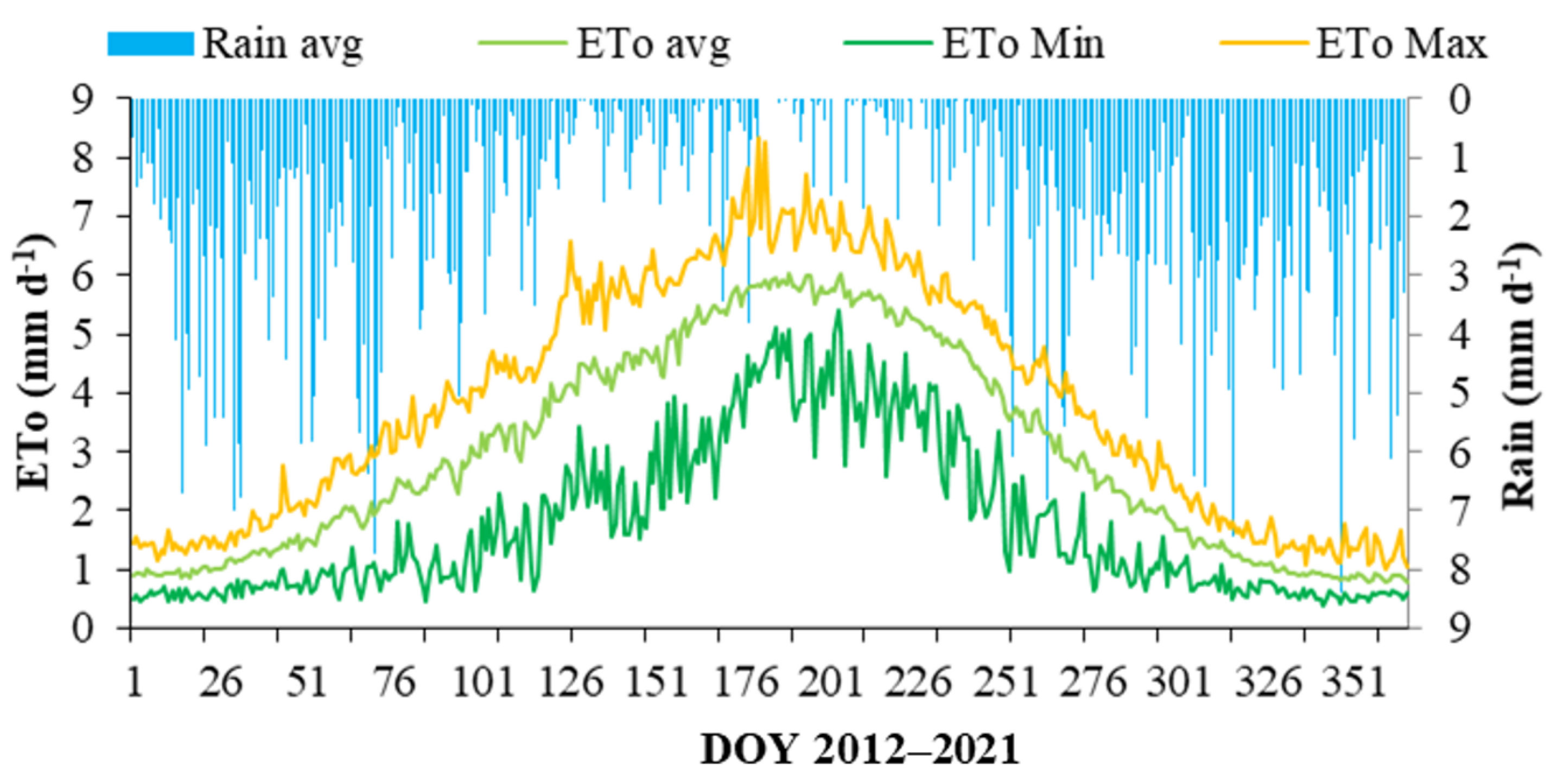
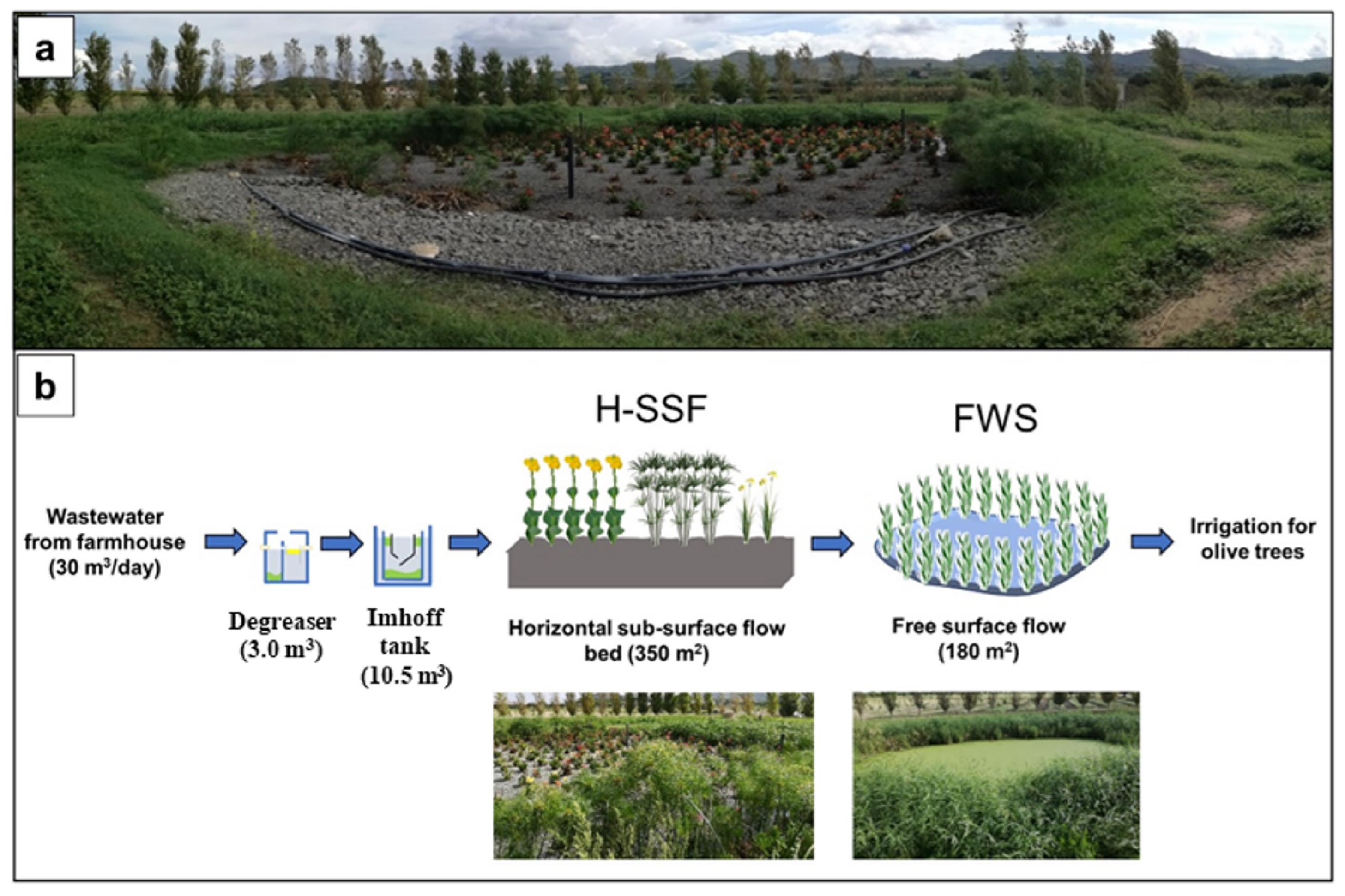

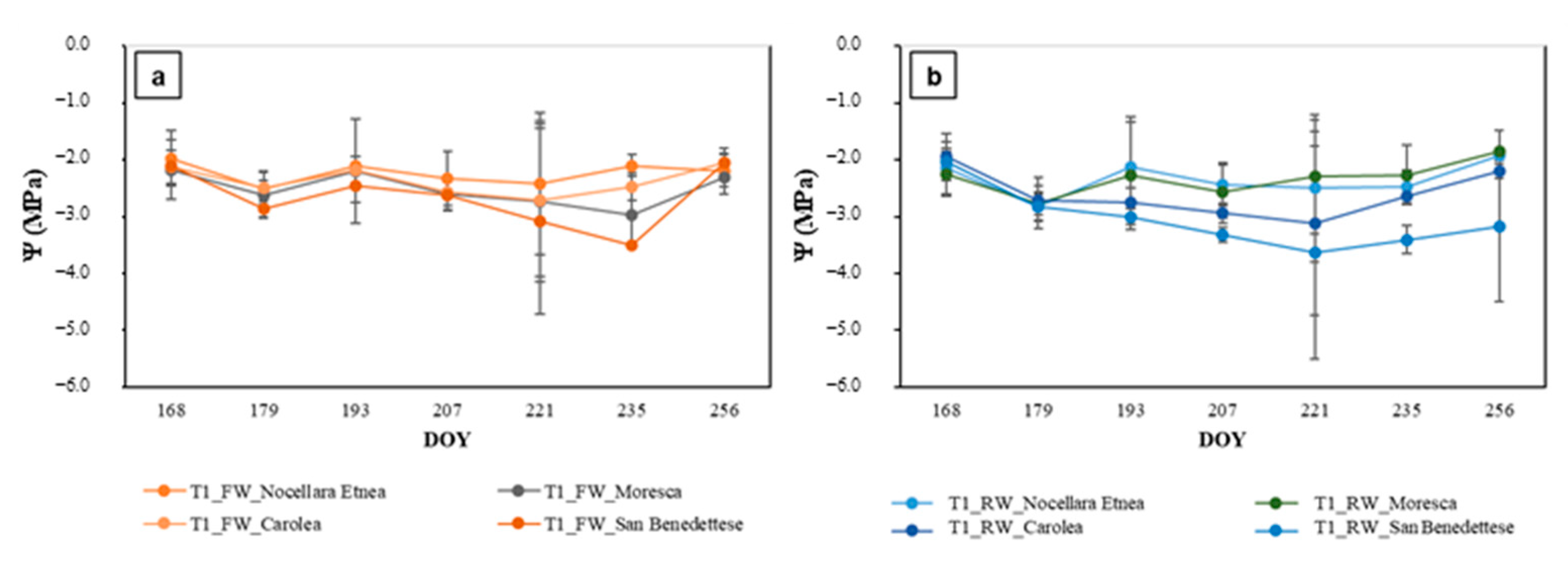


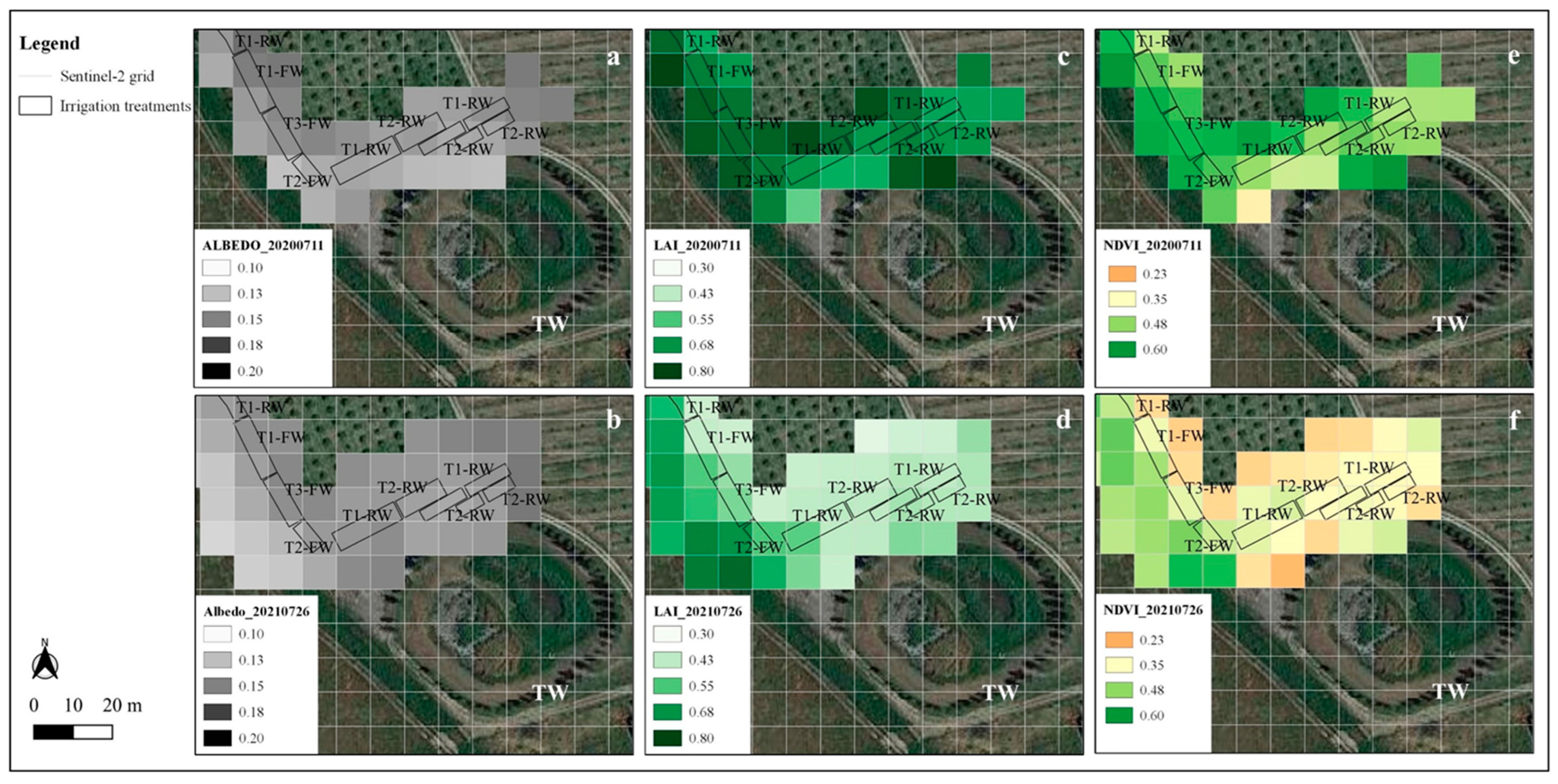
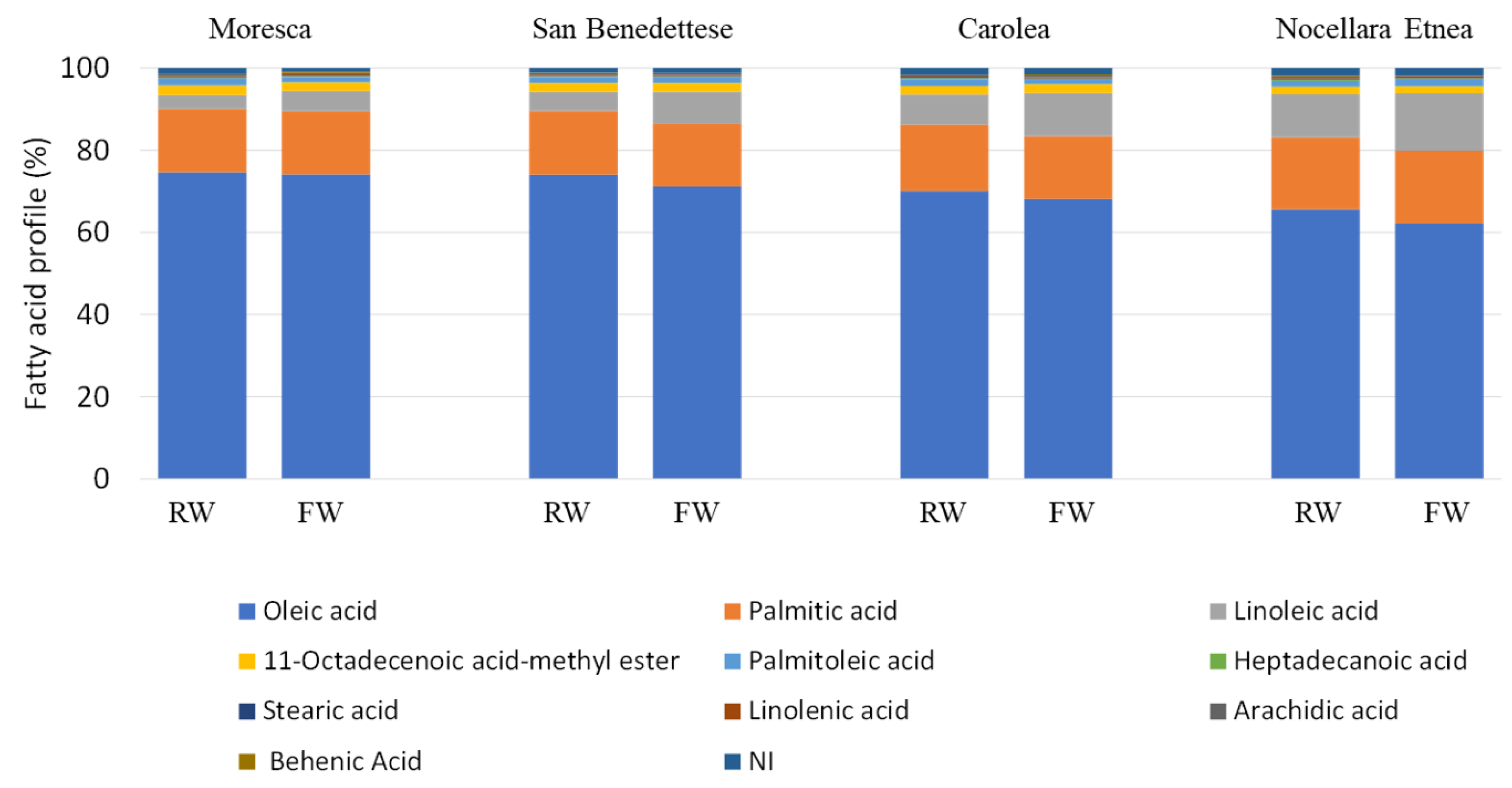
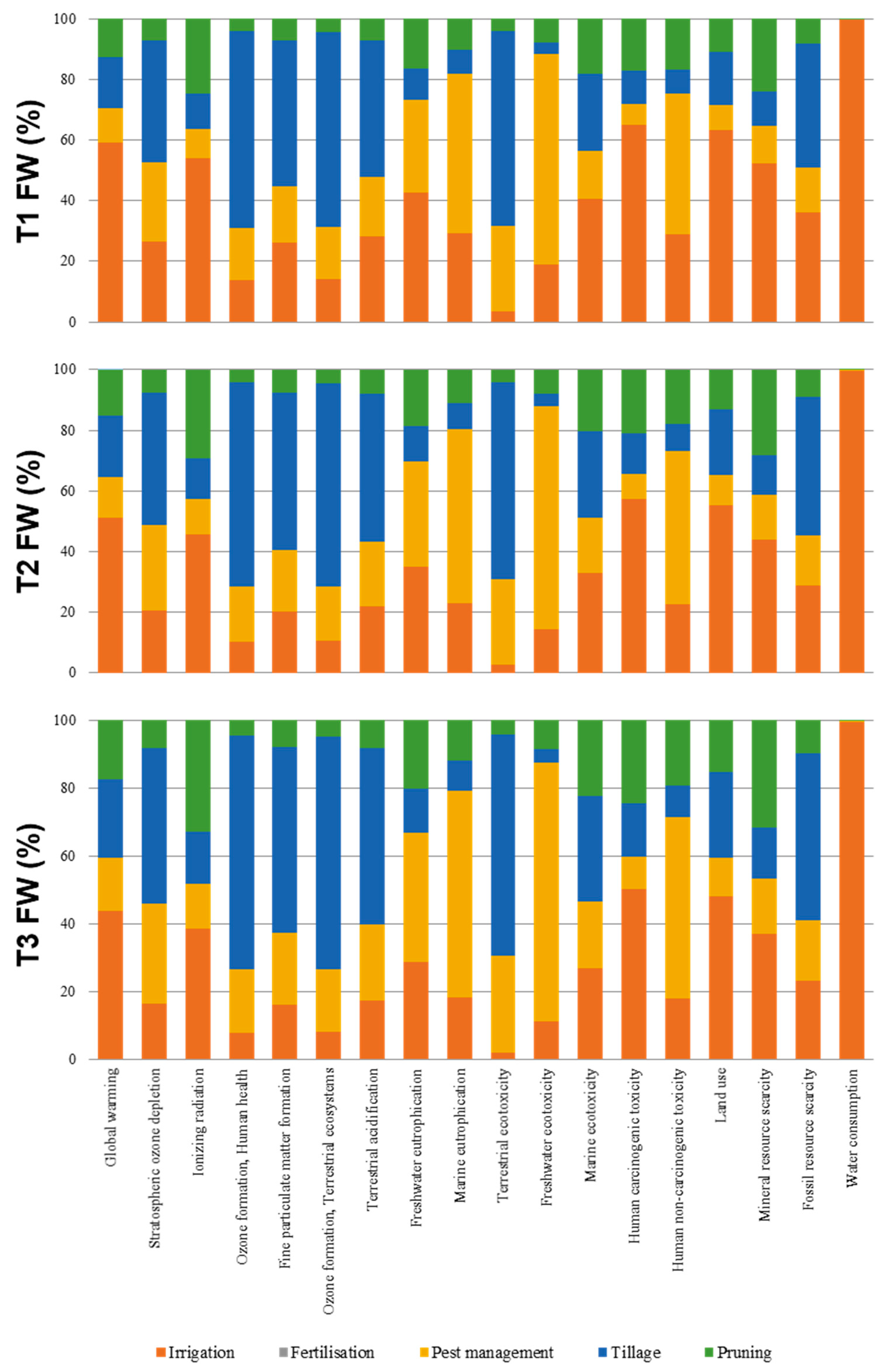

| Parameter | Value | Units |
|---|---|---|
| Surface | 3456.0 | m2 |
| Canopy diameter | 2.8 | m |
| Canopy area | 6.7 | m2 |
| Area of the tree planting layout | 36.0 | m2 |
| Distance among the trees | 6.0 | m |
| Trees number | 96.0 | - |
| Canopy ground cover | 18.6 | % |
| Irrigation Water | Irrigation Treatment | ρa (g cm−3) | FC (cm3 cm−3) | WP (cm3 cm−3) | |||
|---|---|---|---|---|---|---|---|
| FW | T1 | 1.59 | (0.07) | 0.31 | (0.07) | 0.11 | (0.04) |
| T2 | 1.30 | (0.10) | 0.36 | (0.04) | 0.15 | (0.03) | |
| T3 | 1.56 | (0.06) | 0.33 | (0.06) | 0.12 | (0.03) | |
| RW | T1 | 1.53 | (0.14) | 0.34 | (0.02) | 0.11 | (0.02) |
| T2 | 1.51 | (0.14) | 0.31 | (0.05) | 0.11 | (0.03) | |
| T3 | 1.51 | (0.07) | 0.37 | (0.01) | 0.14 | (0.01) | |
| Parameter | Period I | Period II | Unit | |||||||||||
|---|---|---|---|---|---|---|---|---|---|---|---|---|---|---|
| FW (2020–21) | Inlet H-SSF | Outlet H-SSF | Outlet FWS | Inlet H-SSF | Outlet H-SSF | Outlet FWS | ||||||||
| EC | 2806.0 (±68.0) | 3276.0 | (±163.0) | 2928.0 | (±311.0) | 2784.0 | (±808.0) | 2855.0 | (±827.0) | 3203.0 | (±932.0) | 3495.0 | (±923.0) | µS/cm |
| pH | 6.9 (±0.0) | 6.8 | (±0.4) | 7.3 | (±0.3) | 7.5 | (±0.3) | 7.2 | (±0.2) | 7.3 | (±0.2) | 7.5 | (±0.2) | - |
| TSS | 3.0 (±0.0) | 162.0 | (±64.0) | 38.0 | (±23.0) | 31.0 | (±19.0) | 66.0 | (±32.0) | 13.0 | (±4.0) | 17.0 | (±21.0) | mg L−1 |
| COD | 8.0 (±1.0) | 746.0 | (±215.0) | 99.0 | (±90.0) | 71.0 | (±56.0) | 507.0 | (±254.0) | 53.0 | (±26.0) | 52.0 | (±27.0) | |
| BOD5 | 5.0 (±1.0) | 432.0 | (±123.0) | 54.0 | (±54.0) | 38.0 | (±29.0) | 382.0 | (±158.0) | 42.0 | (±18.0) | 24.0 | (±8.0) | |
| N-NH3 | <0.1 | 60.0 | (±15.0) | 18.0 | (±7.0) | 5.4 | (±3.7) | 49.0 | (±20.0) | 14.0 | (±12.0) | 5.5 | (±5.3) | |
| N-NO2 | 1.0 (±0.1) | 8.0 | (±12.0) | 0.2 | (±0.4) | 0.1 | (±0.2) | 5.0 | (±7.0) | 0.0 | (±0.0) | 0.1 | (±0.2) | |
| N-NO3 | <0.1 | 41.0 | (±36.0) | 5.0 | (±10.0) | 0.1 | (±0.3) | 9.0 | (±14.0) | 3.0 | (±10.0) | 0.1 | (±0.2) | |
| Norg | 0.3 (±0.1) | 6.1 | (±1.7) | 0.9 | (±0.5) | 0.5 | (±0.2) | 23.0 | (±28.0) | 2.6 | (±3.9) | 1.5 | (±1.5) | |
| Ntot | 1.4 (±0.1) | 115.0 | (±14.0) | 24.0 | (±14.0) | 6.1 | (±3.7) | 81.0 | (±49.0) | 21.0 | (±18.0) | 6.1 | (±4.5) | |
| P-PO4 | 0.3 (±0.0) | 34.0 | (±11.0) | 20.0 | (±8.0) | 11.0 | (±8.0) | 16.0 | (±12.0) | 9.0 | (±8.0) | 7.0 | (±8.0) | |
| E. coli | n.d. | n.d. | n.d. | n.d. | 7.4 | (±0.3) | 5.7 | (±1.1) | 4.4 | (±1.4) | log10 CFU 100 mL−1 | |||
| Parameter | Period I | Period II | All Periods | Unit |
|---|---|---|---|---|
| TSS | 82 | 71 | 75 | % |
| COD | 90 | 83 | 88 | |
| BOD5 | 90 | 93 | 91 | |
| N-NH3 | 91 | 89 | 90 | |
| N-NO2 | 89 | 86 | 87 | |
| N-NO3 | 100 | 68 | 83 | |
| Norg | 92 | 80 | 86 | |
| Ntot | 94 | 92 | 93 | |
| P-PO4 | 67 | 52 | 59 | |
| E. coli | n.d. | 3.0 | 3.0 | log10 CFU 100 mL−1 |
| Parameter | Italian RW Discharge Limit (1) (mg/L) | Italian RW Reuse Limit (mg/L) | Inlet | Outlet | ||
|---|---|---|---|---|---|---|
| % Samples within the Limits for Discharge | % Samples within the Limits for Reuse | % Samples within the Limits for Discharge | % Samples within the Limits for Reuse | |||
| TSS | 150 (2) | 10 | 75 | 0 | 100 | 35 |
| COD | 125 | 100 | 5 | 0 | 95 | 95 |
| BOD5 | 25 | 20 | 0 | 0 | 57 | 43 |
| Ntot | 15 (3) | 35 | 0 | 6 | 94 | 100 |
| Indications | T1_FW | T3_FW | T3_FW | |||
|---|---|---|---|---|---|---|
| EUR/ha | EUR/kg Olive Oil | EUR/ha | EUR/kg Olive Oil | EUR/ha | EUR/kg Olive Oil | |
| -Revenues | 4165.93 | 6.50 | 5594.06 | 6.50 | 3948.75 | 6.50 |
| -CAP direct payment | 210.00 | 0.31 | 210.00 | 0.24 | 210.00 | 0.28 |
| Total Output Value | 4375.93 | 6.81 | 5804.06 | 6.74 | 4158.75 | 6.78 |
| -Materials | 431.57 | 0.67 | 471.17 | 0.55 | 459.15 | 0.76 |
| -Labor and services | 1443.59 | 2.58 | 1873.23 | 2.50 | 1410.68 | 2.65 |
| -Depreciation and other costs | 1289.39 | 1.69 | 1417.07 | 1.32 | 1278.94 | 1.78 |
| Total Cost | 3164.55 | 4.94 | 3761.48 | 4.37 | 3148.77 | 5.18 |
| Net Value | 1211.38 | 1.88 | 2042.58 | 2.37 | 1009.98 | 1.60 |
| Indications | T1_RW | T2_RW | T3_RW | |||
|---|---|---|---|---|---|---|
| EUR/ha | EUR/kg Olive Oil | EUR/ha | EUR/kg Olive Oil | EUR/ha | EUR/kg Olive Oil | |
| -Revenues | 4339.24 | 6.50 | 5747.63 | 6.50 | 4830.64 | 6.50 |
| -CAP direct payment | 210.00 | 0.31 | 210.00 | 0.24 | 210.00 | 0.28 |
| Total Output Value | 4549.24 | 6.81 | 5957.63 | 6.74 | 5040.64 | 6.78 |
| -Materials | 407.05 | 0.61 | 412.26 | 0.47 | 485.20 | 0.65 |
| -Labor and services | 1658.41 | 2.81 | 1890.92 | 2.46 | 1749.38 | 2.68 |
| -Depreciation and other costs | 1346.49 | 1.69 | 1422.37 | 1.28 | 1376.81 | 1.53 |
| Total Cost | 3411.96 | 5.11 | 3725.55 | 4.21 | 3611.38 | 4.86 |
| Net Value | 1137.28 | 1.70 | 2232.07 | 2.52 | 1429.26 | 1.92 |
| Topics | Advantages and Findings | Future Outlook |
|---|---|---|
| Treatment wastewater efficiency | Higher removal efficiency is obtained when the TW system was at full operation condition (i.e., in 2021) | To perform maintenance operations and integrate the TW system with two phases of the FWS unit |
| Reclaimed water under DI context | Water savings up to 50% and 20% are reached under the T2 and T3, respectively | To conduct long-term experiments to evaluate the effects of water deficit both at the plant and soil level |
| Crop water status | The leaf water potential reflects a different behavior among the genotypes “Nocellara Etnea” shows a better response both under FW and RW | |
| No differences were observed on the biophysical indicators analyzed at the treatment level | To UAV imagery for enhancing the spatial resolution of the applied remote sensing approach | |
| Economic and environmental assessment | Reduction in the economic impacts related to the irrigation treatments that use RW | To acquire a site-specific economic dataset for each local context |
Disclaimer/Publisher’s Note: The statements, opinions and data contained in all publications are solely those of the individual author(s) and contributor(s) and not of MDPI and/or the editor(s). MDPI and/or the editor(s) disclaim responsibility for any injury to people or property resulting from any ideas, methods, instructions or products referred to in the content. |
© 2023 by the authors. Licensee MDPI, Basel, Switzerland. This article is an open access article distributed under the terms and conditions of the Creative Commons Attribution (CC BY) license (https://creativecommons.org/licenses/by/4.0/).
Share and Cite
Vanella, D.; Consoli, S.; Continella, A.; Chinnici, G.; Milani, M.; Cirelli, G.L.; D’Amico, M.; Maesano, G.; Gentile, A.; La Spada, P.; et al. Environmental and Agro-Economic Sustainability of Olive Orchards Irrigated with Reclaimed Water under Deficit Irrigation. Sustainability 2023, 15, 15101. https://doi.org/10.3390/su152015101
Vanella D, Consoli S, Continella A, Chinnici G, Milani M, Cirelli GL, D’Amico M, Maesano G, Gentile A, La Spada P, et al. Environmental and Agro-Economic Sustainability of Olive Orchards Irrigated with Reclaimed Water under Deficit Irrigation. Sustainability. 2023; 15(20):15101. https://doi.org/10.3390/su152015101
Chicago/Turabian StyleVanella, Daniela, Simona Consoli, Alberto Continella, Gaetano Chinnici, Mirco Milani, Giuseppe Luigi Cirelli, Mario D’Amico, Giulia Maesano, Alessandra Gentile, Paolo La Spada, and et al. 2023. "Environmental and Agro-Economic Sustainability of Olive Orchards Irrigated with Reclaimed Water under Deficit Irrigation" Sustainability 15, no. 20: 15101. https://doi.org/10.3390/su152015101
APA StyleVanella, D., Consoli, S., Continella, A., Chinnici, G., Milani, M., Cirelli, G. L., D’Amico, M., Maesano, G., Gentile, A., La Spada, P., Scollo, F., Modica, G., Siracusa, L., Longo-Minnolo, G., & Barbagallo, S. (2023). Environmental and Agro-Economic Sustainability of Olive Orchards Irrigated with Reclaimed Water under Deficit Irrigation. Sustainability, 15(20), 15101. https://doi.org/10.3390/su152015101













